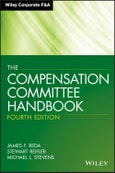Now in a thoroughly updated Fourth Edition, The Compensation Committee Handbook provides a comprehensive review of the complex issues challenging compensation committees that face revised executive compensation disclosure regulations issued by the SEC, as well as GAAP and IFRS rulings and trends. This new and updated edition addresses a full range of functional issues facing compensation committees, including organizing, planning, and best practices tips.
- Looks at the latest regulations impacting executive compensation, including new regulations issued by the SEC, as well as GAAP and IFRS rulings and trends
- Covers the selection and training of compensation committee members
- Explores how to make compensation committees a performance driver for a company
- Guides documentation requirements and timing issues
The Compensation Committee Handbook, Fourth Edition will help all compensation committee members and interested professionals succeed in melding highly complex technical information and concepts with both corporate governance principles and sound business judgment.
Table of Contents
Foreword ix
Preface xiii
Acknowledgments xvii
About the Authors xix
PART One THE MODERN COMPENSATION COMMITTEE 1
CHAPTER 1 The Compensation Committee 3
Board Structure: The Focus on Independence 4
Compensation Committee Composition and Multiple Independence Requirements 5
Compensation Committee Size 10
Compensation Committee Charter 11
Role of the Compensation Committee 13
Role of the Compensation Committee Chair 14
Duties and Responsibilities of the Compensation Committee 14
Compensation Benchmarking 26
The Importance of Compensation Committee Meeting Minutes 29
Call to Action 31
CHAPTER 2 Selecting and Training Compensation Committee Members 33
The Role of the Nominating Committee 33
Nomination and Selection of New Compensation Committee Members 34
Time Commitment 39
Diversity 40
Attracting Candidates 41
Conducting the Search 41
How to Approach Candidates 43
CEO Involvement in the Selection Process 43
Making the Final Selection 44
How to Say No 47
What if the New Director Does Not Work Out? 47
Benefits of an Educated Board 48
Orientation of New Members 49
Ongoing Training 51
Outside Experts and Advisors 53
CHAPTER 3 CEO Succession and Evaluation 59
The Relationship Between Pay and Succession Planning 61
The Advantages of Effective Succession Planning 65
The Succession Planning Process 67
CEO Evaluation 73
CHAPTER 4 Director Compensation 97
Overview 97
Elements of Director Compensation 99
Disclosure 103
Trends in Director Compensation 106
Conducting a Director Compensation Study 109
PART Two LEGAL AND REGULATORY FRAMEWORK 115
CHAPTER 5 Corporate Governance 117
Fiduciary Duties of Directors 117
Practical Applications of Fiduciary Duty Rules 126
Stock Exchange Corporate Governance Rules 131
External Compensation Policies and Guidelines 131
CHAPTER 6 Disclosure of Executive and Director Compensation 143
Background 143
Compensation Discussion and Analysis 144
The Tabular Disclosures 146
Option Grant Practices 154
Director Compensation 155
Disclosure of Material Compensation Risk 155
Compensation Disclosure Requirements for Smaller Reporting Companies 157
Golden Parachute Compensation 158
Pending Dodd-Frank Disclosure Requirements 160
Beneficial Ownership Reporting 162
Disclosure of Related Person Transactions 162
Director Independence and Governance Disclosure 163
Disclosure of Equity Compensation Plans 165
Plan Filing Requirements 167
Form 8-K 168
Selected Provisions of Regulation S-K 168
CHAPTER 7 Other Securities Issues 171
Selected Dodd-Frank Provisions Relating to Executive Compensation 171
Special Rules Regarding Stock Transactions 175
NYSE/NASDAQ Rules: Approval of Equity Compensation Plans 189
Selected Sarbanes-Oxley Provisions Relating to Executive Compensation 193
CHAPTER 8 Tax Rules and Issues 199
Overview 199
Organizations Responsible for Federal Tax 200
Major U.S. Tax Law and Issues 201
CHAPTER 9 Accounting Rules and Issues 255
Overview 255
Organizations Responsible for Accounting Standards (Past and Present) 256
New Equity-Based Compensation Accounting Rules 261
Previous Equity-Based Compensation Accounting Rules Under U.S. GAAP 280
Other Current and Past Accounting Standards 283
CHAPTER 10 ERISA and Labor Law, Rules, and Issues 305
ERISA Law and Regulations 305
Labor Laws and Regulations 309
ADEA Law 310
PART Three PRACTICAL APPLICATIONS 315
CHAPTER 11 Executive Employment, Severance, and Change-in-Control Arrangements 317
Background 317
At-Will Employment Arrangements 318
Contractual Employment Arrangements 319
Fundamental Elements of a Written Employment Arrangement 320
Process 322
Types of Employment Arrangements 323
Terms and Conditions Contained in Employment Arrangements 325
CHAPTER 12 Incentive Compensation 349
Useful Definitions and Abbreviations 349
Cash versus Equity 352
Typical Plan Features and Designs 353
Shareholder Approval Requirements 364
Retention-Only Plans 364
CHAPTER 13 Equity-Based Compensation 367
Equity-Based Incentive Awards 367
Stock Ownership and Retention Guidelines 384
CHAPTER 14 Executive Pension-Benefit, Welfare-Benefit, and Perquisite Programs 387
List of Programs 388
Pension-Benefit Arrangements 388
Welfare-Benefit Arrangements 397
Perquisites 400
APPENDIX A Selected SEC Rules, Regulations, Schedules, and Forms 405
APPENDIX B List of Organizations and Periodicals 511
APPENDIX C List of Director’s Colleges and Other Training Opportunities 519
APPENDIX D Sample Compensation Committee Charters 527
APPENDIX E Sample Compensation Discussion and Analysis (CD&A) 547
Glossary 633
Bibliography 685
Index 699








